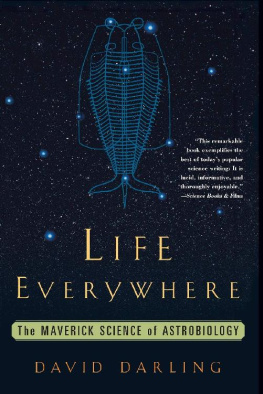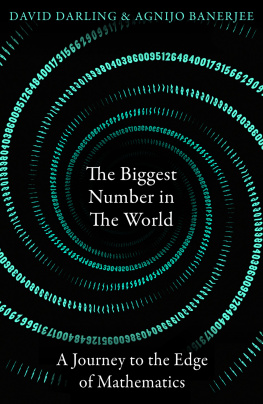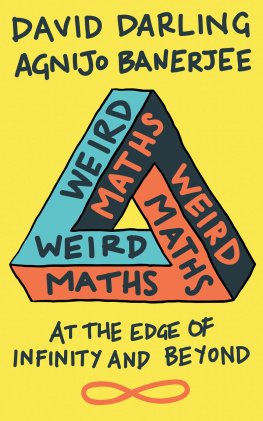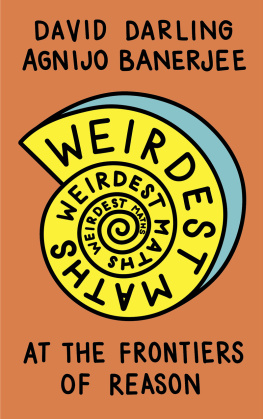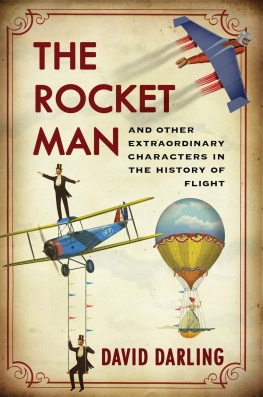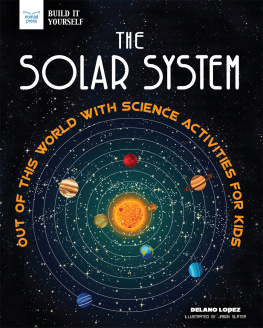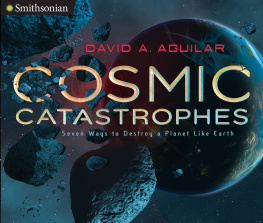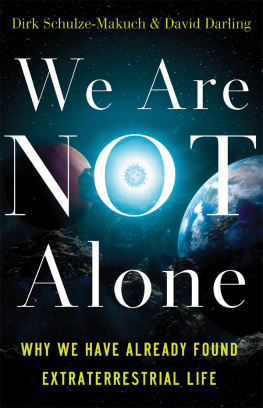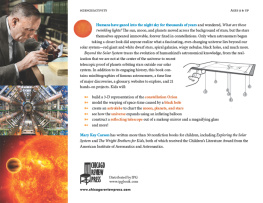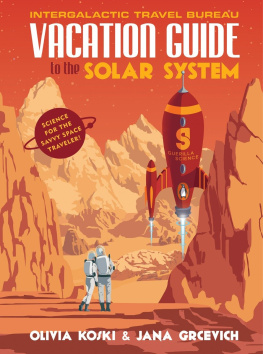MEGACATASTROPHES!
Understandable, interesting, and entertaining: the perfect excuse to learn science from the atomic to the galactic and from the terrestrial to the extra-terrestrial. Well-written and accessible to any audience... A book specially recommended for those who think that the end of humankind cannot cheer you up.
Alfonso Davila SETI Institute
Who needs vampires and zombies for excitement when we live in a world beset by so many real threats to life, limb, and happiness? Delightful... an authoritative but good-humored look at an array of natural and technological disasters.
Albert A. Harrison Professor Emeritus of Psychology, University of California, Davis, and author of Starstruck: Cosmic Visions in Science, Religion and Folklore
Nicely written, thoroughly researched, and highly recommended. Doomsday is already marked in the calendar.
Alberto Fairen NASA Ames Research Center
ABOUT THE AUTHOR
Dr David Darling is an astronomer, freelance science writer, and creator of one of the most popular online encyclopedias of space and astrobiology. He is the author of the bestselling Equations of Eternity.
Dr Dirk Schulze-Makuch is Professor in Astrobiology at Washington State University. His research has been widely published in media ranging from academic journals to The New Scientist.
Together they are the authors of the critically-acclaimed We Are Not Alone.

A Oneworld Book
Published by Oneworld Publications 2012
Copyright David Darling and Dirk Schulze-Makuch 2012
The moral rights of David Darling and Dirk Schulze-Makuch to be identified as the Authors of this work has been asserted by them in accordance with the Copyright, Designs and Patents Act 1988
All rights reserved
Copyright under Berne Convention
A CIP record for this title is available from the British Library
ISBN 978-1-85168-905-7
ISBN 978-1-78074-027-0 (Ebook)
Typeset by Jayvee, Trivandrum, India
Cover design by Richard Green
Oneworld Publications
185 Banbury Road
Oxford OX2 7AR
England
Learn more about Oneworld. Join our mailing list to find about our latest titles and special offers at:
www.oneworld-publications.com
ILLUSTRATIONS
ACKNOWLEDGEMENTS
Our thanks go to our editor at Oneworld, Mike Harpley, for his insightful suggestions and enthusiasm, Louis Irwin and Ed Guinan for helpful advice on some of the chapters, and Jeff Darling for rendering a number of the illustrations. Most of all, we are grateful to our families for their love and support while this book was being prepared.
INTRODUCTION
We live in a quiet backwater of an ordinary, middle-aged spiral galaxy, circling one of the more sedate kinds of stars, on the surface of a stunningly life-friendly planet. Nature has dealt us a very kind hand indeed. But that doesnt mean were completely safe or that we can afford to be complacent.
Space rocks as big as houses zip by us, closer than the Moon, every few months or so; some the size of large mountains have smashed into the Earth in the past causing serious mayhem. Giant stars explode, supervolcanoes erupt, ice ages come and go, the very fabric of space and time might rip apart at any moment if some theories are to be believed. And if these potential natural disasters arent enough, there are threats of our own making in the form of new technologies that could spin out of control. We might even fall victim to an alien attack seriously just like in the good old B-movies of the 1950s.
Not that theres any need to panic. Almost certainly the world wont end this week, or in our lifetime, or in our childrens childrens lifetimes. But its possible, even if we manage to avoid pressing the nuclear button, that the human race, and even the Earth itself, could be wiped out in less time than it takes you to read these pages. Or the end might come more gradually but still uncomfortably fast, over the space of a few years or a few centuries. The destruction might involve more than just our planet, too. There are ways in which the entire universe, with its hundreds of billions of galaxies scattered across billions of light years, could slip swiftly into oblivion without warning and with more than a little human help.

Prophesying the end of the world has always been a popular pastime. At the time of writing, the more excitable Internet forums, the tabloid press, and late-night radio talk-shows are gripped by tales of a coming apocalypse. December 2012 is the fateful month, some say, when, according to an ancient calendar of the Mayans, everything is going to go horribly pear-shaped. But before blowing your lifes savings on one last outrageous street party, it may be worthwhile reading the small print on this prediction.
The calendar in question is whats called the Mesoamerican Long Count calendar, which supposedly began 5,125 years ago. In 1966, the American archaeologist and anthropologist Michael D. Coe argued that the current, fourth age of the Long Count would come to an end on December 21, 2012, and that this date would have been highly portentous to the Mayans living centuries ago. There is a suggestion, he wrote, that Armageddon would overtake the degenerate peoples of the world and all creation on the final day ... [O]ur present universe [would] be annihilated when the Great Cycle of the Long Count reaches completion.
Although Coe remains a respected figure, most Mayan specialists today disagree with him on this particular issue. The consensus view among scholars is that, although the Mayans believed in world ages, they made no predictions about any catastrophe happening at the end of the present cycle. Nothing in their records suggests anything other than that they saw it as the prelude to yet another world age, which, in their minds, would have been a cause for celebration rather than fear.
Pseudoscientists and pseudohistorians, however, arent prone to letting the opinions of experts get in the way of a good story. The 2012 Phenomenon is alive and kicking, and will doubtless remain so until December 22 when we wake up to find that the Earth hasnt been knocked off its axis, or suffered any other ill effects from obscure cosmic alignments, geomagnetic reversals, or close flybys of unknown planets. If past experience is anything to go by, explanations of how we survived will quickly emerge, and new doomsday forecasts will appear to replace the ones that didnt quite work out. And, as always, these revised dire warnings will find a ready and eager audience.
Apocalyptic predictions have been doing the rounds for thousands of years. An Assyrian clay tablet dating back to about 2800 BCE warned: Our earth is degenerate in these latter days. There are signs that the world is speedily coming to an end. Doom-mongers throughout the ages have had a uniformly dismal success rate.
Often, as in the case of the 2012 prophesy, the date when everything will unravel is pinpointed with great precision to the embarrassment of the author when the world continues on its merry way past the appointed time. Early in Romes history, many Romans feared the city would be destroyed in the 120th year of its founding. There was a myth that a dozen eagles had revealed to Romulus a mystical number representing the lifetime of Rome, and it came to be supposed that each eagle represented ten years. Since the Roman calendar began in what is our 753 BCE , the date of destruction was put at 634 BCE .
In more recent times, hardly a year has gone by without someone staking their (often dubious) reputation on a prediction that the Day of Judgment or the Rapture is nigh. The year 2010, for instance, was the last time anyone needed to print calendars according to the Hermetic Order of the Golden Dawn. In 2011 it was the turn of Harold Camping and his California-based Family Radio group to declare that May 21 would see the Second Coming of Christ. Campings followers emptied their bank accounts trying to spread the word and were less than pleased to find themselves still stuck on a very material world and totally broke. Meanwhile New Hampshire atheist Bart Centre made a killing by setting up Eternal Earth-Bound Pets and charging clients $135 a time for insurance policies that guaranteed care for animals whose owners had ascended to a better place. British physicist Brian Cox tweeted: I think we should all pretend the rapture is happening so that when Harold Camping gets left behind later today hell be livid.
Next page

